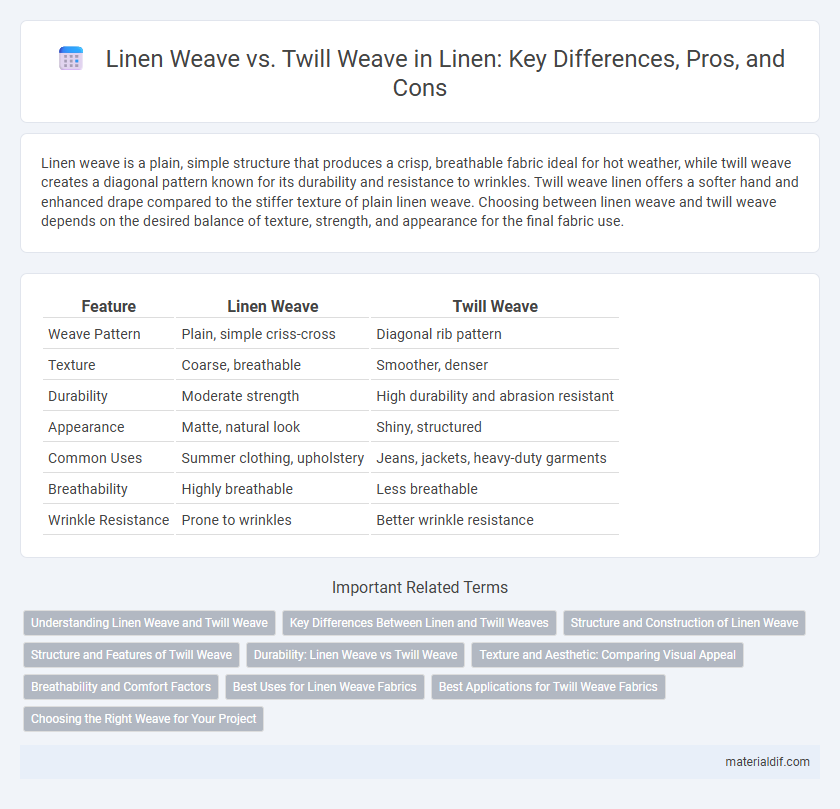Linen weave is a plain, simple structure that produces a crisp, breathable fabric ideal for hot weather, while twill weave creates a diagonal pattern known for its durability and resistance to wrinkles. Twill weave linen offers a softer hand and enhanced drape compared to the stiffer texture of plain linen weave. Choosing between linen weave and twill weave depends on the desired balance of texture, strength, and appearance for the final fabric use.
Table of Comparison
| Feature | Linen Weave | Twill Weave |
|---|---|---|
| Weave Pattern | Plain, simple criss-cross | Diagonal rib pattern |
| Texture | Coarse, breathable | Smoother, denser |
| Durability | Moderate strength | High durability and abrasion resistant |
| Appearance | Matte, natural look | Shiny, structured |
| Common Uses | Summer clothing, upholstery | Jeans, jackets, heavy-duty garments |
| Breathability | Highly breathable | Less breathable |
| Wrinkle Resistance | Prone to wrinkles | Better wrinkle resistance |
Understanding Linen Weave and Twill Weave
Linen weave features a simple, plain weave pattern where warp and weft threads cross alternately, producing a crisp, breathable fabric ideal for warm climates. Twill weave, characterized by diagonal rib patterns created through the over-under weaving technique, offers enhanced durability and a softer drape compared to linen weave. Both weaves utilize linen fibers but differ in texture and strength, impacting their suitability for applications like clothing, upholstery, or household textiles.
Key Differences Between Linen and Twill Weaves
Linen weave features a plain, simple over-under pattern that creates a crisp texture, while twill weave exhibits diagonal ribbing known for its durability and flexibility. Linen weave typically produces a stiffer, more breathable fabric ideal for summer clothing and home textiles, whereas twill weave offers enhanced strength and drape, commonly used in denim, chinos, and upholstery. The difference in weave construction affects the fabric's appearance, weight, and wear characteristics, making linen weave more suitable for lightweight, airy garments and twill weave better for heavy-duty, structured applications.
Structure and Construction of Linen Weave
Linen weave is characterized by a plain weave structure where warp and weft threads intersect alternately, creating a simple crisscross pattern that maximizes fabric durability and breathability. This construction results in a balanced texture with a firm yet flexible feel, showcasing the natural luster of flax fibers. Contrastingly, twill weave features a diagonal rib pattern formed by floating warp or weft threads, providing increased strength but less uniform texture than the classic linen weave.
Structure and Features of Twill Weave
Twill weave in linen exhibits a distinctive diagonal rib pattern created by the weft thread crossing over one or more warp threads before going under one or more warp threads, enhancing fabric durability and flexibility. This structure allows for greater resistance to wrinkles and a softer drape compared to the plain linen weave, making it ideal for garments requiring both comfort and resilience. The diagonal texture in twill weave linen also improves its aesthetic appeal, adding depth and visual interest to the fabric surface.
Durability: Linen Weave vs Twill Weave
Linen weave, characterized by a simple crisscross pattern, offers moderate durability suitable for lightweight applications, while twill weave features a diagonal pattern that enhances fabric strength and resistance to wear. Twill weave fabrics, such as denim and chino, are generally more durable than plain linen weaves due to their tighter construction and ability to hide stains and creases. For heavy-use items requiring longevity, twill weave linen provides superior durability compared to traditional linen weave.
Texture and Aesthetic: Comparing Visual Appeal
Linen weave offers a crisp, grid-like texture with a matte finish, emphasizing simplicity and natural appeal, while twill weave presents a diagonal ribbed pattern that creates a richer, more textured surface with a subtle sheen. The visual appeal of linen weave is characterized by its uniformity and classic look, ideal for minimalist and rustic designs. Twill weave enhances depth and dimension, making it popular for more sophisticated or casual styles.
Breathability and Comfort Factors
Linen weave offers exceptional breathability due to its loose, open structure, allowing air to circulate freely and keep the fabric cool and comfortable in warm weather. Twill weave, while denser and more durable, provides less airflow but enhances fabric strength and wrinkle resistance, contributing to comfort through long-lasting wear. Choosing between linen and twill weave depends on prioritizing airflow and coolness versus durability and smooth texture in warm climate clothing.
Best Uses for Linen Weave Fabrics
Linen weave fabrics, characterized by their plain, crisscross pattern, offer exceptional breathability and durability, making them ideal for summer clothing and home textiles such as tablecloths and curtains. Their smooth surface and firm texture provide a natural luster, preferred in lightweight shirts, dresses, and upholstery. Unlike twill weave's diagonal ribbing, linen weave's balanced structure resists wear and enhances airflow, perfect for applications requiring comfort and moisture-wicking properties.
Best Applications for Twill Weave Fabrics
Twill weave fabrics, characterized by their diagonal rib pattern, offer enhanced durability and resistance to wrinkles compared to plain linen weaves, making them ideal for high-traffic applications like upholstery and workwear. Their ability to drape smoothly and maintain strength under stress suits tailored garments such as suits, trousers, and outerwear. The weave's distinctive texture also adds visual interest, favoring home textiles like curtains and cushion covers where both aesthetics and performance are essential.
Choosing the Right Weave for Your Project
Linen weave, characterized by its simple crisscross pattern, offers breathability and a smooth surface ideal for lightweight, airy fabrics such as summer clothing and curtains. Twill weave, featuring diagonal lines, provides enhanced durability and resistance to wrinkles, making it suitable for heavy-duty applications like upholstery and workwear. Selecting the right weave depends on balancing aesthetic preferences with functionality, where linen weave promotes softness and breathability while twill weave ensures strength and longevity.
Linen Weave vs Twill Weave Infographic

 materialdif.com
materialdif.com